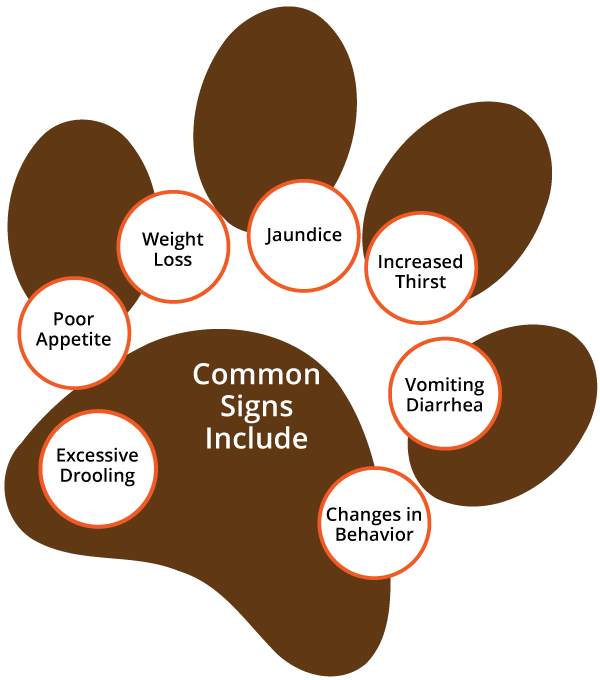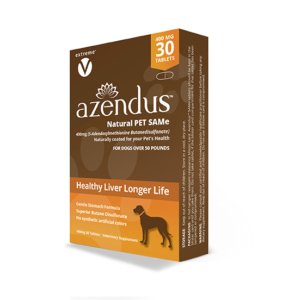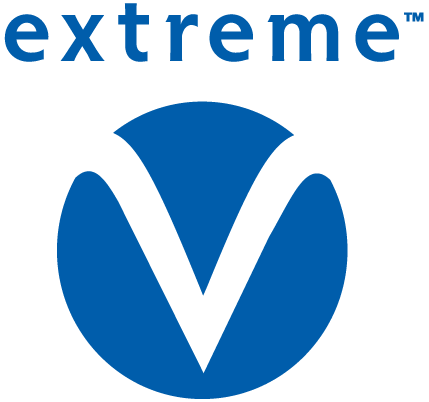PET SAMe
 Azendus™ – PET SAMe
Azendus™ – PET SAMe
Pets are family members and deserve the best possible forms of nutrition and supplementation. We realize that our pets are subject to constant environmental stresses such as air, water and land pollution. The liver often has to work overtime to deal with factors such as agricultural chemicals and heavy metals(lead, arsenic and mercury) in foods, over chlorinated water in municipal waters supplies, exhaust fumes from passing cars and truck, unfortunately the list goes on and on. Many conscientious pet owners take their companions in for regular wellness exams, including organ function tests. As pet owners ourselves we are often concerned when our veterinarians alert us to changes in blood tests and liver enzyme levels, especially for aging dogs and cats. Most knowledgeable pet guardians are very aware of how important liver function is to their animal’s health, longevity, and quality of life.
Changes in liver enzyme values from one blood test to the next are actually quite common, and elevations in liver enzymes do not automatically indicate organ disease. While any abnormal value should be addressed, there are several factors to consider when reviewing test results. These include which liver values have increased, how much they have increased, and how long the elevation has persisted. This is one reason to ask your veterinarian to go over the test results with you in the exam room, or ask for a copy of the results and review them at home, adding them to your pet’s medical file so you can compare them to future test results.
There are a number of blood serum chemistry values your veterinarian uses to determine how well your dog’s or cat’s liver is functioning. The values most commonly measured include:
- ALP (alkaline phosphatase)
- ALT (alanine transaminase)
- AST (aspartate transaminase)
- Bilirubin
- Albumin
Elevations in Alanine Transaminase (ALT)
However, the liver has regenerative powers, so slightly higher than normal rates of cell death, or short periods of significant cell death, may be resolved by the liver’s ability to regenerate tissue. As a general rule, veterinarians consider that ALT values two to three times normal warrant further investigation, while lower elevations in a clinically normal animal can be closely monitored through regular rechecks.
Also, ALT is present in intestinal as well as liver cells, so a serious GI disease can cause mild elevations in this enzyme.
Elevations in Aspartate Transaminase (AST)
Elevations in Bilirubin
In some animals with normal liver function, a disease that causes rapid destruction of red blood cells may elevate bilirubin. While the liver may be healthy, the disease causing the death of red blood cells (including auto immune issues, heavy metal accumulation, toxins, parasites or infectious disease) needs to be immediately diagnosed and treated.
Low Levels of Albumin
Low albumin should be investigated, especially in pets that appear well nourished.
Diagnosing Liver Disease
In light of this, it’s important to never rely on a single ALT or AST value to arrive at a definitive diagnosis or prognosis. Increased ALT or AST values should be rechecked regularly, along with other markers of liver disease and liver function.
Since a definitive diagnosis of liver disease often requires a biopsy, many veterinarians faced with abnormal liver values in a pet, first try to rule out non liver-related diseases that might contribute to the abnormal values.
Abnormal liver enzymes signal there is liver damage occurring, but they are not a measure of liver function or health. The two-part blood test that measures liver function is called a Bile Acids Test, and it is the test that is recommended by veterinarians if liver enzymes continue to climb, or if the patient is symptomatic.
If all other potential conditions are eliminated, the next step is typically to do an ultrasound exam of the liver, the gallbladder, and surrounding tissues.
If your pet is seriously ill and/or other diagnostic tests return ambiguous results, unfortunately, a liver biopsy may be the only remaining option to accurately diagnose your four-legged family member’s condition, and evaluate available treatment options. Try to avoid this invasive procedure if possible, but sometimes it’s the only way to diagnose certain liver diseases.
Recheck, Recheck, Recheck
If your pet has no symptoms of disease and you opt to provide a holistic liver support protocol, rechecking liver enzymes to ensure they have returned to normal is important for your peace of mind and to identify progressive liver disease before a crisis occurs. If your pet is ill, identifying the root cause (including infectious disease, metal accumulation, degenerative, inflammatory or immune-mediated disease or a congenital/structural problem) will allow your vet to formulate the best treatment protocol as early as possible, giving your furry friend the best chance for a speedy recovery and a good quality of life.
Importance of Liver Detoxification
Age, stress, injury, and a host of other contributors can result in less-than-optimal detoxification for your pet. Sometimes the build up of toxins simply becomes too great for your pet’s body to handle.
If toxins and waste cannot be removed through normal detox processes, several problems can arise, including:
- Your pet’s body attempts to remove the excess toxins through his skin, resulting in itchy, scaly, and dry skin.
- Your pet’s body tries to shed toxins and waste through mucous membranes, leading to eye discharge, teary eyes, or a runny nose.
- Your pet’s body stores the overload of toxins to be handled later.
Toxins and unwanted waste that is not removed can remain and build up in your pet’s body and can potentially lead to less-than-optimal health.
The nutrients that assist the detoxification process can become depleted when your pet is under stress, exposing her body to even more potential damage from environmental factors.
As threatening as all this sounds, there are natural ways to support your pet’s normal detoxification processes and promote optimal health. Azendus PET SAMe is one alternative recommended by many vets.
Does my dog have liver disease?
The signs of liver disease can be very similar to those of other conditions. If you notice any of the following signs in your dog, contact your veterinarian for a complete examination. Symptoms to look out for include:
- Poor or loss of appetite
- Weight loss
- Jaundice (yellowing of skin and whites of eyes)
- Increased thirst
- Vomiting or diarrhea
- Changes in behavior
- Excessive drooling
- Lack of energy or depression
Other possible signs of liver disease in dogs include dark-colored urine, pale gums or a buildup of fluid in the abdomen that could be mistaken for sudden weight gain. Your veterinarian can administer tests to diagnose liver disease.

IMPORTANT: The signs of liver disease are not very specific, making it difficult to recognize. If your dog is not eating, consult your veterinarian immediately.
The importance of Azendus PET SAMe
If your dog is diagnosed, you may be wondering how to take care of your dog with liver disease. Treatment of any hepatic disease is aimed at resting the liver and minimizing those functions that have to do with metabolism of fats, proteins, carbohydrates and drugs. Controlling nutritional copper intake may benefit dog breeds predisposed to accumulate toxic levels of copper in the liver. Low-dose of 25mg zinc, such as Gluzin (www.gluzin.com) is a good natural source to block excess copper absorption.
The liver has an amazing ability to repair and regenerate itself, and therapeutic supplementation plays a vital role in this process. Azendus PET SAMe supports liver function and detoxification as the liver heals.
For accurate diagnosis and therapeutic support options, always consult your veterinarian for your pet’s liver health.
Questions to Ask Your Veterinarian on Liver Disease
- Are there any foods I should avoid giving my dog to ensure a healthy liver?
- Ask how human food can affect your dog’s health.
- Would you recommend Azendus PET SAMe for my dog’s liver health?
- Ask about special nutritional concerns for your dog
- How much / how often you should feed the recommended food to your dog
- Discuss which treats you can feed your dog with the recommended food
- How quickly should I expect to see signs of improvement in my dog’s condition?
- Can you provide me with written instructions or a handout on liver health?
- What is the best way (email/phone) to reach you or your hospital if I have questions?
- Ask if you need a follow-up appointment.
- Ask if a reminder email or notice will be sent.



